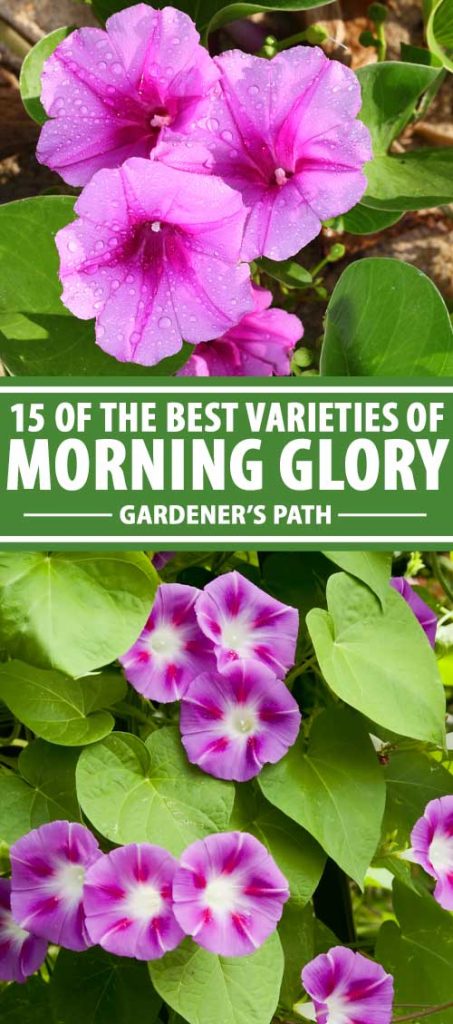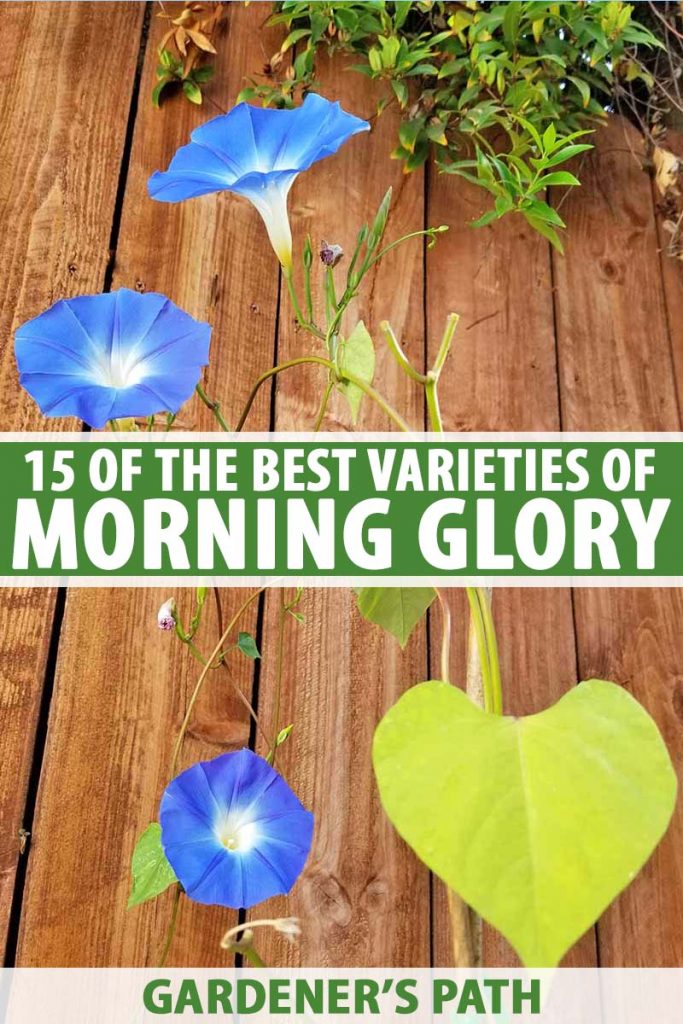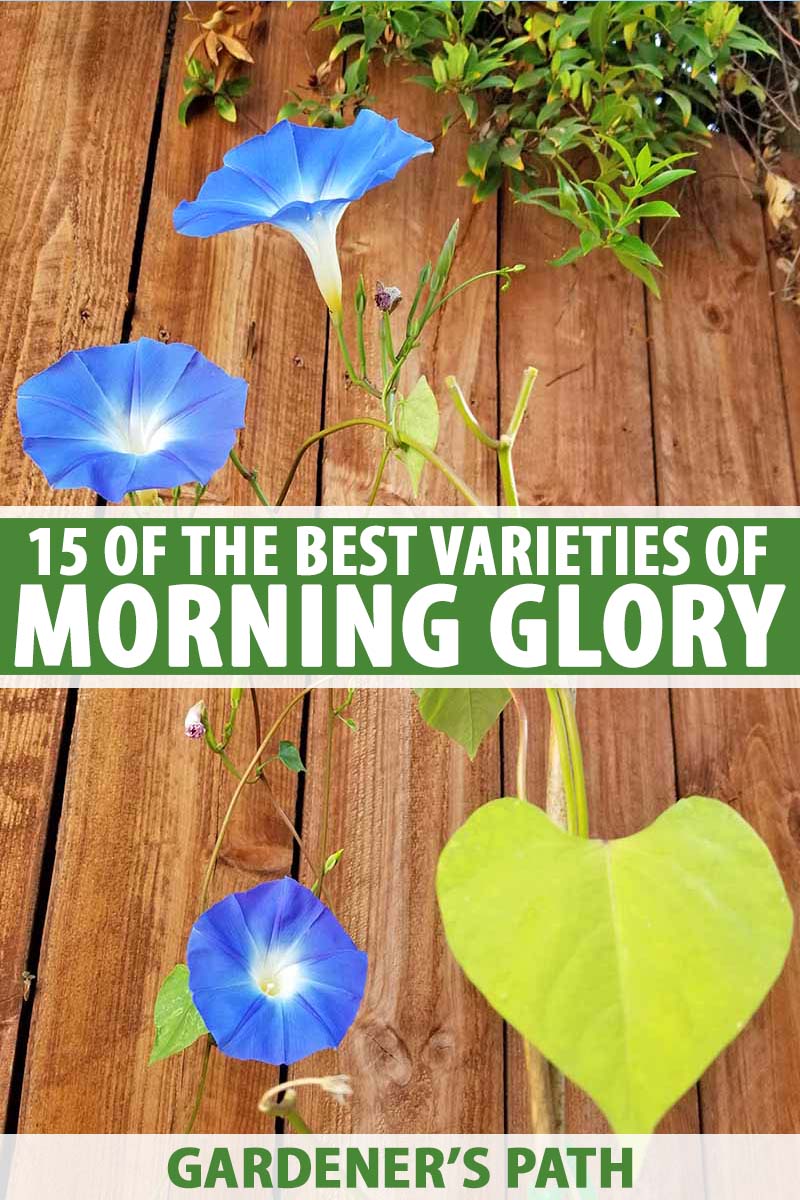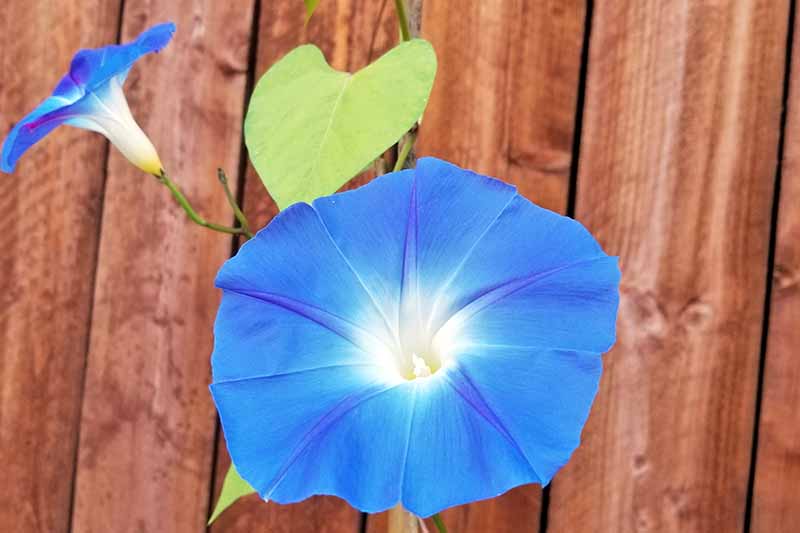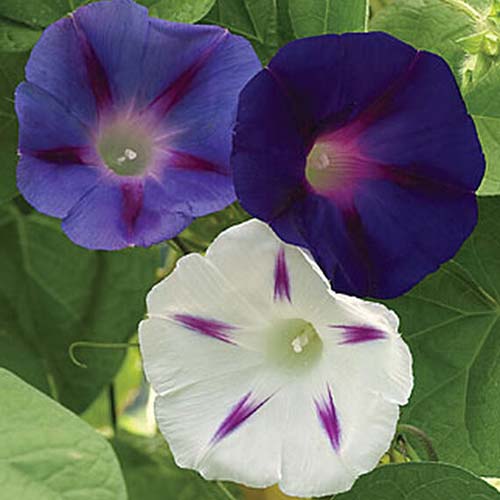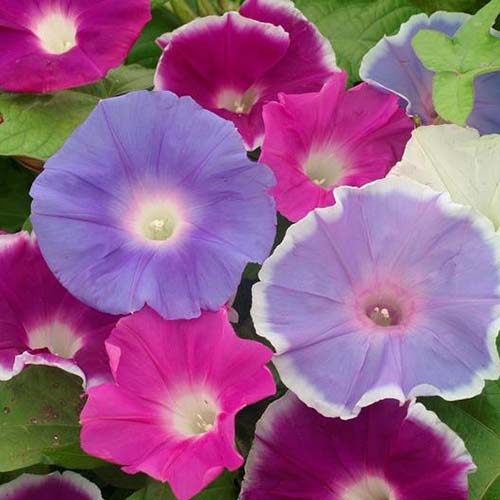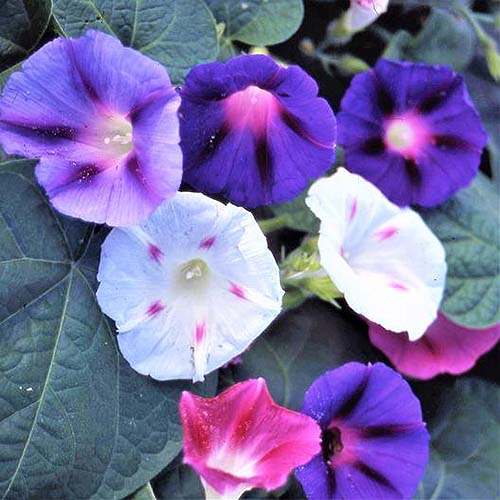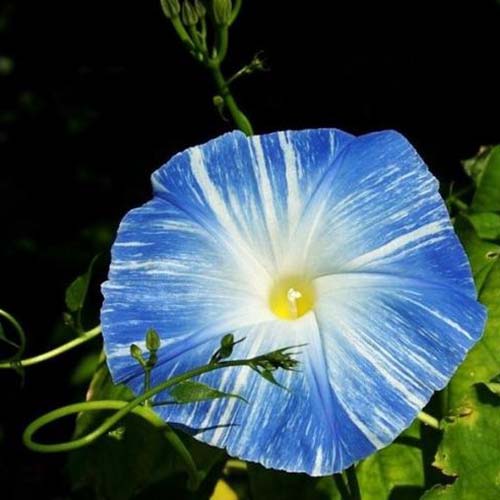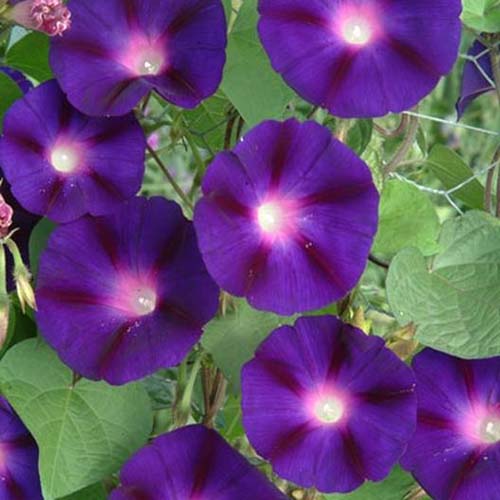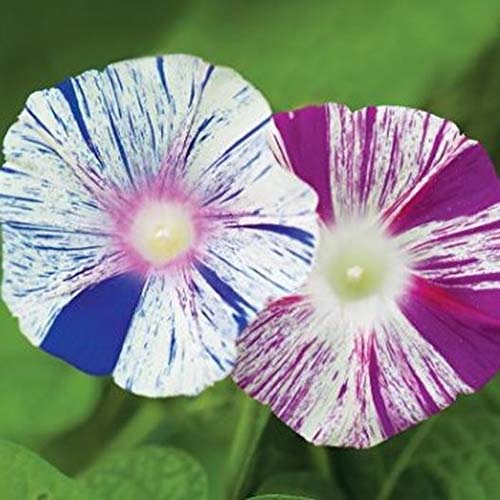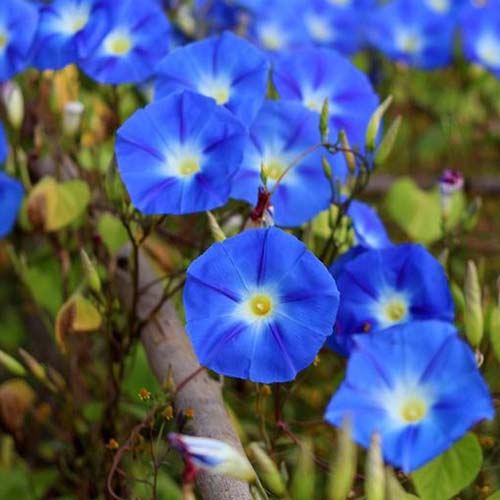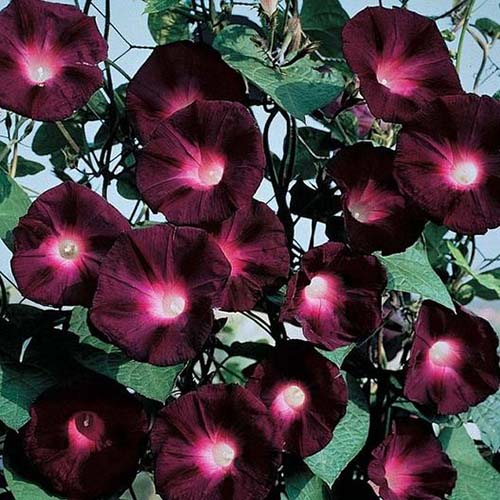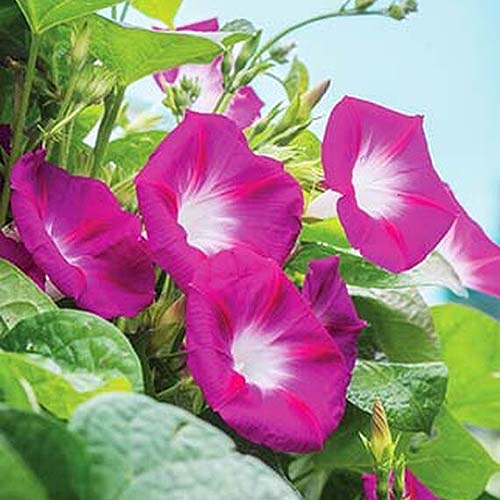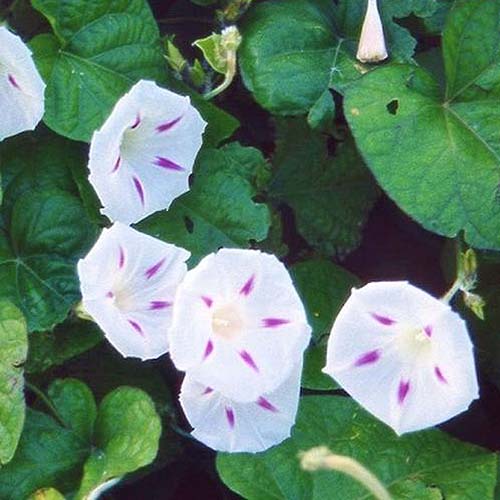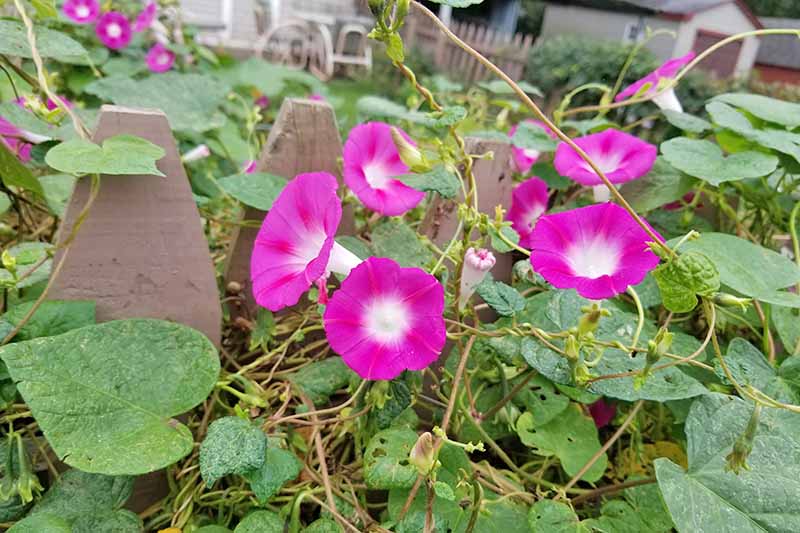Most of the types of common morning glory, or Ipomoea purpurea, that you’re going to find grow as annuals, unless you’re in USDA Hardiness Zone 10 or 11. However, they are happy (and eager) to self-seed for a repeat performance next year. If you want to avoid that sometimes aggressive self-seeding process, remove the plants entirely from an area in the late fall, before they become crispy and ready to shoot seeds everywhere. We link to vendors to help you find relevant products. If you buy from one of our links, we may earn a commission. These flowers need full sun, not too much water, and pretty much any type of soil you have to offer. Check out our complete morning glory growing guide to brush up on what you need to know to get this colorful flower growing at its best in more detail, then pick your favorite variety below to start planting! Let’s take a look at some of our top picks, for stunning blooms to cover a fence or trellis.
1. Caprice
Sky blue with a lavender star at the center, ‘Caprice’ is a real monster of a grower, even among morning glories. The vines can reach up to twenty feet in length, enabling it to cover vast amounts of space. The color combinations here practically glow in intensity, with a pleasing spectrum of saturation.
‘Caprice’ It pairs well with groundcover vinca vine, and this pair is among your best options for those areas that gotta get covered, and fast! Luckily ‘Caprice’ can tolerate partial shade as well. Find seeds in a variety of packets sizes, available at Eden Brothers.
2. Carnevale di Venezia
For a hint of blue or purplish pink, ‘Carnevale di Venezia’ won’t disappoint. The petals have streaks of color on a white background and are all different, adding a bit of variety. It will reach a spread of up to 10 feet and about 16 feet in height at maturity. This is a vigorous grower, that’s for sure!
‘Carnevale di Venezia’ I’ve found flowers with this two-tone hue comprised of white and another color work best when paired with solid colors, rather than adding more variegated or two-toned mixes to the garden. Petunias would also work here, but some upright black-eyed Susans and lupine can be game changers when paired with these flowers. The seeds from a plant this size will self-sow en masse, so don’t worry about starting afresh the following season. Packets of 10 seeds are available at Burpee.
3. Celestial Mix
Can’t make up your mind on what to grow? Why not try the ‘Celestial’ mix? You’ll find whites, blues, and purples in this mix, and after you sow the seeds you’ll have a random kaleidoscope of color to enjoy – there’s really no way to tell what they’re going to look like until they bloom. Even seeds saved from these plants will likely deviate from their original color and develop new color patterns.
‘Celestial’ Mix It’ll be hard to know exactly how big the vines are going to grow, but you can expect them to reach somewhere around nine feet in total length. That’s a good size to cover a fence, a trellis, or an arbor. Planting this cultivar is a roll of the dice because you just don’t know what you’re going to get, but that’s part of the fun! Boasting blooms with a range somewhere between blue and purple and with a white mix sometimes thrown in, they’re guaranteed to complement each other. Find packets of 50 seeds available at Burpee.
4. Crimson Rambler
Pinkish-red, intensely hued flowers are what you’ll get if you choose ‘Crimson Rambler.’ And that name is on the nose for these vines in terms of habit as well, since they grow up to fifteen feet in length. That whole “crimson rambler” thing also makes me think of that similarly named automobile from the 60s, like the one my aunt had parked in her driveway collecting rust for about thirty years. It’s those little details that instill certain plants with qualities that make them our favorites.
‘Crimson Rambler’ This morning glory can tolerate partial shade, but I’d argue those blooms will look their best if grown in full sun. This type is a natural pair with roses or common geraniums. Include a hummingbird feeder to attract swarms of those hovering birds, and butterflies alike; they’ll come for the feeder but stay for the flowers! Find seeds in a variety of packet sizes available at Eden Brothers.
5. Early Call Mix
The ‘Early Call’ Mix is an exercise in pastel colors. Talk about some gorgeous blooms here! They practically melt into each other, and are highlighted by that occasional white border on a flower. The vines reach a length of about 15 feet and the plant can fortunately tolerate some partial shade. The more sun the plant has, the larger it gets, so in shadier conditions expect it to reach about 10 feet.
‘Early Call’ Mix I’d argue the ‘Early Call’ mix should be kept at a lower height and trained to run along a fence, or halfway up one. I base that suggestion entirely on how spectacular the flowers are and my belief that sometimes, less is more. Including a pastel carpet (or low-growing wall) of morning glories is as good-looking as a garden can get. Find seeds in packages ranging from less than an ounce up to a 1-pound sack available at Eden Brothers.
6. Fieldgrown Mix
White, pink, and purple flowers, oh my! The ‘Fieldgrown’ mix is a shining example of colorful, vibrant flowers. These morning glories tolerate partial shade, and can bring a rich display to otherwise shady areas. The vines reach a respectable length of about ten feet. Upright phlox makes a suitable pairing with these colors.
‘Fieldgrown’ Mix The ‘Fieldgrown’ Mix is another one of those roll-of-the-dice options, resulting in colorful flowers in a variety of hues that are impossible to predetermine. You’ll just have to wait and see what you get. Find seeds in a variety of packet sizes available at Eden Brothers.
7. Flying Saucers
Subtlety isn’t a quality that springs to mind when I think of morning glories, but ‘Flying Saucers’ manages to pull this off with gusto. You’re probably asking yourself, can subtlety be pulled off with gusto? Lay your eyes on these flowers and see it in action.
‘Flying Saucers’ Every flower is a summery sky blue, with streaks of white and a sunny yellow center. It’s like marrying the sky to the ground, creating a beautiful partnership. And the vines can climb up to about fifteen feet. A notable quality to ‘Flying Saucers’ is their tolerance for partial sun, allowing you to plant these somewhere that gets a bit of shade throughout the day. Talk about a lifeline for those of us without perfect light! White geraniums and gardenias would pair delightfully with ‘Flying Saucers.’ Seeds are available in a variety of packet sizes from Eden Brothers.
8. Grandpa Ott
I like this one for its name alone. ‘Grandpa Ott’ is a familiar sight among morning glory fans. Dark purple blossoms with a red star-shaped throat mark this as an iconic and familiar flower.
‘Grandpa Ott’ Or maybe this type is new to you? Either way, it makes a stunning addition to the garden. This cultivar grows vines up to fifteen feet long, making it perfect for covering a wall or fence with profuse purple flowers. Those flowers are a few inches across, nice and big for a good show. For a serious display of color you could double these up with hyacinth beans, but be prepared for some messy vines to remove after the season is through! Seeds are available from Eden Brothers.
9. Harlequin Mix
Striped white, pink, andpurple flowers identify the ‘Harlequin’ Mix. A random array of bluish, purplish stripes on a white petal offer unique flowers on each vine. You can expect it to reach lengths of up to twelve feet or so, a nice distance for covering arbors from bottom to top.
‘Harlequin’ Mix One of my favorite gardens has a simple fountain with a rock wall covered in ‘Harlequin’ morning glories, with no other plant pairings. Sometimes these flowers are displayed to their best advantage when they’re alone and allowed to be the sole showmen. Seeds are available in a variety of package sizes up to 1/4-pound packages at Eden Brothers.
10. Heavenly Blue
The ‘Heavenly Blue’ cultivar is an heirloom variety, the plant that “started it all” in launching the US morning glory craze. You can’t beat that blue, can you? Expect this variety to spread as far as six to eight feet over the season, reaching heights of up to twelve feet! Such a vigorous grower is at its best on a trellis or fence. This annual plant should be cut back and removed in the late fall.
‘Heavenly Blue’ Consider combining ‘Heavenly Blue’ with some similarly hued lobelia and forget-me-nots, to keep that blue vibe cruisin’. Or, combine it with pink and purple petunias to offer some complementary color that plays off their soft hue. You can find seeds in a variety of packet sizes available from Eden Brothers.
11. Inkspots
With beautiful bicolored flowers in shades of purple, blue, and white, ‘Inkspots’ is a prolific bloomer. The trumpet-shaped flowers are ideal for growing up fences and trellises.
‘Inkspots’ A fast-growing variety, vines reach up to 10 feet long, and will tolerate partial shade. Find seeds in a packets of various sizes available at Eden Brothers.
12. Knowlians Black
Not quite black, you will enjoy the deep purple blooms of ‘Knowlians Black.’ All I can say here is, “Wow, what a flower.” This intense color is exceptional and instantly garners my attention. It surely will grab the gaze of anyone walking by. Also, that name – ‘Knowlians’? Love that, probably because New Orleans is one of my favorite places on earth.
‘Knowlians Black’ The vines will reach lengths of about eight feet and are slower growing than other morning glories, which can be a good thing for the busy gardener. A slower growing plant means less maintenance. This variety also tolerates some partial shade. The seeds are available in a variety of package sizes at Eden Brothers.
13. Party Dress
Magenta blooms are in the spotlight with ‘Party Dress.’ It’s the white center that contrasts with that rich magenta that really sells it to me. Modest for a morning glory, these vines reach lengths of about six feet and are good candidates for covering smaller areas, or if you want a vine that won’t grow beyond its intended boundaries.
‘Party Dress’ This strikes me as a good choice for fences, mailboxes, and lampposts. That color is easily partnered with any other full-sun-loving annual like geraniums and petunias, and it is a perfect pair with echinacea. Packets of 50 seeds are available at Burpee.
14. Seta
White blooms with purple flecks in a star-shaped pattern identify the ‘Seta’ morning glory. White or yellow flowers are my favorite, and the white shades of this flower are just right. The purple flecks never shout or demand attention, they only complement the modest white flowers of this vine. That allows the profuse flowers of this morning glory to act as a backdrop to other plants in the garden.
‘Seta’ The vines can reach a length of about twelve feet and this plant tolerates partial shade – not a bad deal! Seeds are available in a range of various package sizes at Eden Brothers.
15. Venice Blue
White with a striped pattern in shades of blue, this morning glory looks like it was designed by Jackson Pollock on a good day. ‘Venice Blue’ is something of a wild card selection because every flower will feature slightly different shades of blue. However, because it has a strong white background on each flower petal, it’s easy to pair up with other plants in the garden if you want it all to jibe and sing the same song.
‘Venice Blue’ In particular, I imagine this variety pairing quite well with ‘Night Sky’ petunias. The vines and tendrils will climb to around twelve feet, and it prefers full sun conditions. Seeds are available from in a variety of packet sizes and in a large 1-pound sack at Eden Brothers.
Glory, Morning, Noon, and Night
Morning glories offer plenty of variety to choose from, and you’re just about guaranteed to find one with the colors and traits you are looking for. Their easy-to-grow quality is yet another bonus.
Are you growing morning glories? What’s your favorite variety? Let us know in the comments below and feel free to share a photo or two! And for more information about growing vines in your garden, you’ll need the following guides next:
How to Grow and Care for Passionflower How to Grow Crossvine How to Grow Carolina Jessamine
Photos by Allison Sidhu © Ask the Experts, LLC. ALL RIGHTS RESERVED. See our TOS for more details. Product photos via Burpee and Eden Brothers. Top uncredited photo by Allison Sidhu. Other Uncredited photos via Shutterstock. With additional writing and editing by Clare Groom and Allison Sidhu.
